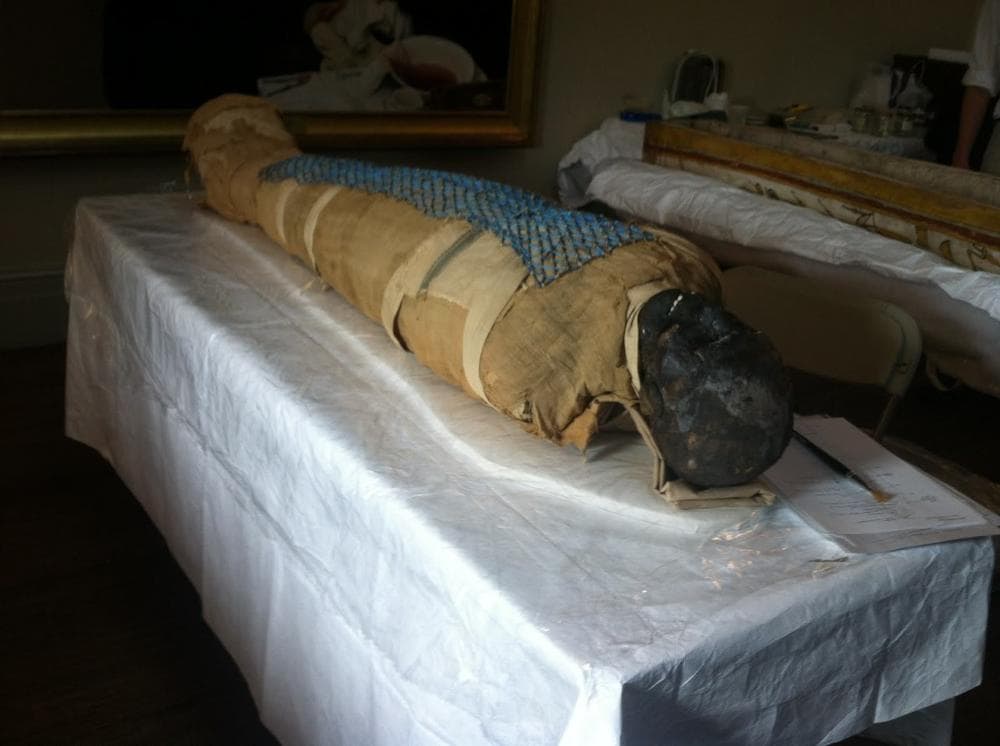Advertisement
The Man Behind The Mass. General Mummy

Over the weekend, Padihershef, the most famous mummy in Boston, was treated to a facelift.
Since 1823, when the city of Boston donated him to the hospital as a medical oddity, Padihershef — nicknamed Padi — has kept a silent vigil in his ornate but fading coffin in the Ether Dome, the amphitheater of Massachusetts General Hospital.
He has been privy to pedagogical surgeries performed in front of generations of medical students. But this weekend, it was Padi’s turn to take the stage.
Mimi Leveque, a seasoned mummy conservator and restorer of ancient artifacts, performed what she called a “mummy spa-treatment,” in which she removed salt deposits from Padi’s face using swabs dipped in saliva, while a team of medical experts examined MRI scans of the hospital's ancient resident.
The effort aimed in part to answer the question that has haunted the Ether Dome for nearly two centuries: Who is the man behind the mummy?
A few things are known about the mysterious Padi. About 2,500 years ago, 40-year-old Padihershef was unmarried and working as a stone-cutter in the Necropolis in Thebes.
Bone X-rays from 1931 and 1976 revealed stunted bone growth in Padi’s skeleton, suggesting he suffered from a grim illness in his childhood.
Part of the weekend’s hubbub was to compare these older bone scans to recent MRI’s to get a better understanding of how Padi died. Leveque speculates that his bones may have been subject to a slow crushing from a large object, one theory of the cause of Padi’s death.
Whatever it was that annihilated the stone-cutting bachelor centuries ago, the afterlife has been kind to Padihershef’s looks and reputation. Lying between the top and bottom cases of his coffin — which was also receiving some modernizing restorative re-vamps — his celebrity mummy’s skin was deeply bronzed, encasing high cheekbones and a grin of teeth so white that even the slickest game-show host would be impressed.
Advertisement
“The Egyptians didn’t have sugar the way we do," Leveque said. "Teeth preserve well.”
Padi’s fresh new look was not accompanied by a fresh new scent. On Friday, the air in the Etherdome had a strange, but subtle, stench that smelled like crayons dipped in rubbing alcohol.
Leveque reassured observers that the wafts were simply coming from the resins that were used to soak the shrouds that wrapped around Padi’s small body.
She explained that even though these days Padi looks small, he wasn’t necessarily that tiny back in his waking life in Thebes.
“They certainly shrink during mummification," she said. "If you can imagine how much of your body is water; if all of that water is removed, think of dried fish you know, like baccalà."
"You start out with a fish that’s this big.” She holds her gloved hands 12 inches apart, then moves them closer together. “Then you end up with a fish that’s that big and that’s exactly what’s happened to the body.”
This program aired on June 10, 2013. The audio for this program is not available.